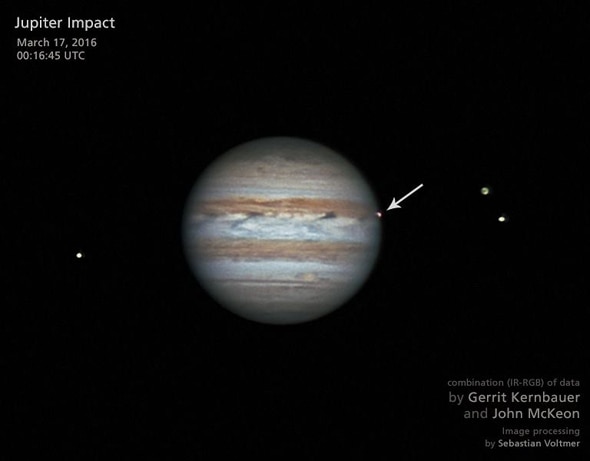Create a free profile to get unlimited access to exclusive videos, sweepstakes, and more!
Jupiter May Be Hit by a Half-Dozen Visible Asteroid Impacts Every Year

In 1994, Jupiter was pummeled by the repeated impacts of the comet Shoemaker-Levy 9. The comet had been caught by the planet’s gravity earlier, torn apart by the tidal force during a close pass, and then each chunk slammed into Jupiter’s upper atmosphere and exploded, one by one, over the course of a week.
These impacts were easily seen from Earth (I saw the dark dust clouds peppering the cloud tops of Jupiter myself through a 15 cm telescope!), the first time any body other than Earth had been unambiguously seen to be hit by a comet or asteroid.
Since that time, five more impacts have been seen: in 2009, June 2010, August 2010, 2012, and 2016. In each case, the events were caught accidentally by amateur astronomers when they were taking video of Jupiter!
This raises the question: How often is Jupiter actually hit by an object big enough to make a flash visible from Earth?
At a workshop held earlier in May to encourage amateur astronomers to observe the planet in support of the upcoming arrival of the Juno mission to Jupiter, astronomers announced they have an estimated answer: Jupiter gets visibly hit by six to seven chunks of cosmic debris every year.
Yegads. That’s a lot!
They determined that number not just by the times amateurs have seen impacts on Jupiter, but also by how much they didn’t. If you happen to look at Jupiter and see an impact, you can’t know if you were just lucky; you have to observe the planet for a long time to see just how much it gets hit. In this case, observations from about 60 amateurs totaling more than 56 days of video were analyzed to look for impacts. None were seen, but that provides a valuable baseline for the impacts that were caught by accident by other amateurs.
While this is an estimate (and has not been through the peer-review process), it jibes with the numbers I was coming up with based on the impacts we’ve seen; on the order of once per year (meaning one to 10 times). And that’s only the impacts we can see; we miss half because they hit the far side of Jupiter, facing away from Earth, plus some when they occur within a few weeks of the time Jupiter is behind the Sun as seen from Earth.
Clearly, what we need here is a bigger team of astronomers across the Earth observing Jupiter, so we cover it as much as possible. The folks at the Juno workshop are working on that, as well as improving software that will allow analysis of video taken.
Why video? Well, it gives better time coverage of the planet—a single exposure is generally less than a second (Jupiter is bright through a telescope!), and a video can run for a long time. Also, Earth’s atmosphere boils and seethes, blurring out small details in astronomical targets. Video frames can be very short exposures, helping minimize that blur. Plus, one part of Jupiter might be relatively unaffected in one frame, while a different part of the planet looks better in a different frame. Sections of different video frames can be cropped out and reassembled to create a single, high-resolution shot of the planet. This is a relatively standard technique used by amateurs these days, and was how those more recent impacts were discovered.
As for the science, that part is pretty interesting. The impacts we see (with the exception of Shoemaker-Levy 9) are from pretty small asteroids, probably just a few dozen meters across. Jupiter’s ridiculously strong gravity pulls them in so hard that they are moving five times faster than impacts on Earth on average, making them 25 times brighter (energy released goes as the square of the impact velocity). In that case, even a smaller body can make a bright flash.
Asteroids that small are impossible to see directly from Earth because Jupiter is so far away. So the impacts on Jupiter give us an indirect way to figure out how many such objects are out there. Also, we don’t see too many impacts on other objects (pretty much just the Moon), so the more we see the more we can understand these events. I’m all for that.
As an aside, astronomy is one of the very few fields of science where amateurs* can make valuable contributions. Big professional telescopes are oversubscribed, and can’t afford the time to sit and stare at Jupiter for nights on end. In cases like this (and in many, many others) people with their own ‘scopes really fill a big gap in our understanding.
As someone who considers himself both an amateur and a professional astronomer, I love this. Science should be for everyone, whether you just want to learn more about it, enjoy it yourself, or participate in it directly. Astronomy is a fantastic way to do all of these things.
*Like so many other things in astronomy, there’s no good definition of what an “amateur” is. Someone who isn’t paid? Someone who does it as a hobby, or once a year when they haul a ‘scope out to look at the Moon, or who has done it for so long they know the sky like the back of their hand and write their own software to analyze their observations and create gorgeous images or scientific data? Yes.














